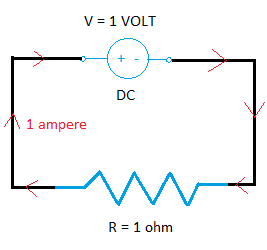Ohm's law
Ohm's law is a formula discovered by Ohm which helps us to measure the electric current in a circuit.
Before I show you what the formula is, we need to define the voltage source and the electric resistance.
What is voltage source?
In the lesson about electric current, we showed that the electric current is a flow of electric charge.
Well, charges don't flow unless it is connected to a voltage source such as a battery.
Simply put, a voltage source is like an electric pump. For example, a battery is like an electric pump since the positive terminal of the battery will attract electrons or negative charges as already explained in the lesson about electric current.
Another example of voltage source is a generator. Electric power companies use big generators in order to deliver 120 volts to home outlets.
In summary a voltage source is a device used to move electric current in a circuit. The higher the voltage, the more current will flow in the circuit. Home outlets can deliver 120 volts while a AA battery could deliver 1.5 volts.

DC stands for direct current such as batteries, solar cells, etc...
AC stands for alternating current such as your home outlets.
What is electric resistance?
While a voltage source causes current to flow in a circuit, an electric resistance will resist the flow of electric charge in a circuit. A device which causes electric resistance is called a resistor.
The electric resistance may depend on the following factors
- The conductivity of the material
- The thickness of the material
- The length of the material
- The temperature
Some materials allow charges to flow more easily. For example, copper is a better conductor than iron.
Thin wires have more resistance than thick wires.
Longer wire have more resistance than short wires.
The higher the temperature, the more the conductor will resist the flow of electric charges.

Ohm's law formula
Ohm's law shows the relationship between the current, the voltage, and the resistance.
Based on what we saw so far, the electric current (I) depends on the voltage and the resistance.
The unit for the resistance is Ohm.
Notice that the voltage is in the numerator. It makes sense since as the voltage increases, so will the electric current. On the other hand, the resistance is in the denominator. As the resistance increases, the electric current will also decrease.
1 ampere is the resulting current when the voltage is 1 and the resistance is 1 ohm.

Ohm's law quiz
Take this Ohm's law quiz to see how well you understand Ohm's law.
After completing this quiz with 100% accuracy, you will know exactly
what the Ohm's law is and how to use it to solve problems. You will not
need to use a paper and pencil to complete this quiz.
First, read the lesson about Ohm's law and then take this quiz.
Objective of the Ohm's law quiz:
- Identify the Ohm's law formula
- Know what a voltage source is
- Know what an electric resistance is
- Use Ohm's law to find the current or the voltage
|
Test your knowledge with the quiz below: |